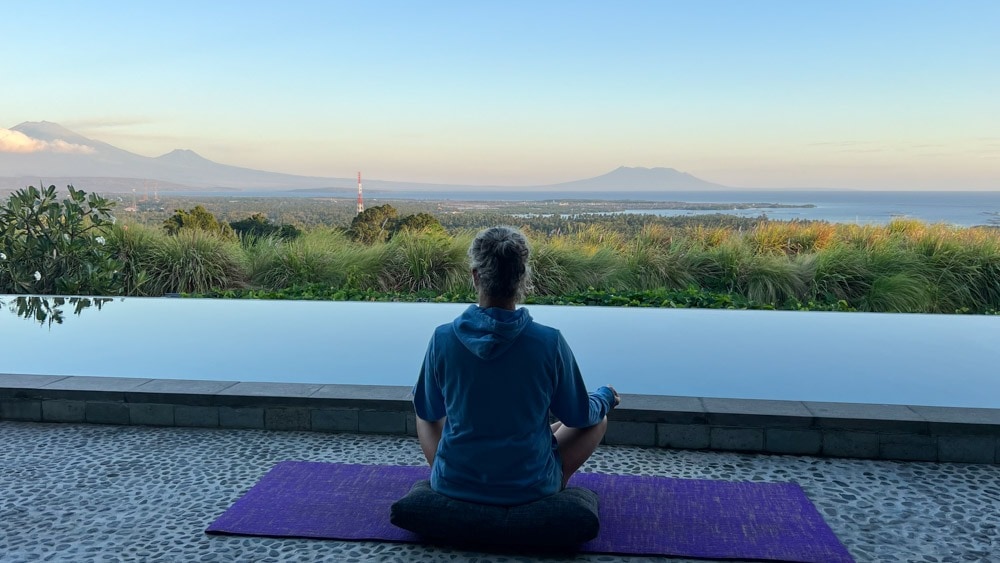Good posture, unfortunately, is not always good for your body. In fact, it’s often really bad for your body – because good posture is not the same as good alignment!
On the surface, good posture and good alignment look really similar.
Your shoulders should indeed line up over your hips, not way out in front of you. And your upper back certainly should not round forward into a slouch.
So you pull your shoulders back, lift your chest to stand up straight, and boom! Everything lines up and your posture is now fabulous!
This sounds like a great solution, but sadly, what you’ve really done is set yourself up for chronic pain and injury. Here’s why.
You Can’t Fake Alignment
The problem is that non-moving, chair-sitting, TV watching, computer-using bodies have adapted to our lives and have literally been shaped by these activities.
The muscles at the front of your chest are super short and tight. Pulling your shoulders back doesn’t change the length of these muscles, it just displaces them, and creates other problems elsewhere.
The same with having a straight back. Instead of dealing with the issue – a largely immobile, overly flexed thoracic spine – we thrust out our lower ribs. This just displaces the immobility. It looks better, but it actually causes even more issues without fixing the original problem.
Just like so many parts of life, it takes time and hard work to fix your body. Faking it might look good but in the long run, it’s not that great for you.
Posture Fix: Pull Your Shoulders Back
I’m sure you’ve been told a trillion times to pull you shoulders back.
I’m here to tell you to stop pulling your shoulders back RIGHT NOW.
Here’s the deal:
Your glenohumeral joint (aka the GHJ, the true shoulder joint, where your arm bone meets your body) IS too far forward.
But, all that happens when you pull your shoulders back is that you move your shoulder blades towards your spine.
This drags your shoulder joint further back in space, but doesn’t change the real issue.
The real problem is that your arm bones are internally rotated and your pectoralis muscles are too short. Both things that aren’t changed when you pull your shoulders back.
Posture Fix: Lift Your Chest & Straighten Your Back
Your upper back is probably way stiffer and more bent forward than you would like to imagine.
Almost everyone (including me) has a far more hunched upper back than we would like.
The technical term is hyperkyphosis and there is a hidden epidemic of hyperkyphosis in North America.
Why is it hidden? Mostly because of good posture, actually.
When you’re bent forward, how do you fix it? By bending the other way, of course.
That’s what standing up straight or lifting your chest is supposed to help you do.
BUT we are so stiff and tight in our upper backs that this fix doesn’t actually help most of us. Instead of bending through all our joints a little bit, we almost always bend through one joint a lot.
That means that one single joint (typically the one between the T12/L1 vertebrae) takes the load that all the rest are supposed to carry.
It visually displaces the problem so you look better, but inside there is a very uneven stress happening for your spine.
Start healing your pelvic floor, building a functional core & caring for your spine (for free!)
Reason #1 – Pulling Your Shoulders Back Is Bad For Your Spine
When you pull your shoulders back, you do not fix the real issue.
But you DO destabilize your spine.
The connective tissues and muscles between the shoulder blade and the spine are part of your body’s way of keeping your upper back straight.
However, when you pull back your shoulders, you hold them in an artificially shortened position. Now your spine has nowhere to go but forward.
So this posture fix is actually pushing your spine into the very position that you’re trying to avoid.
Which I think is messed up.
The more your spine is destabilized and rounded forward, the more unnatural loading it’s getting, potentially leading to pain, vertebral fractures, and osteoporosis.
Reason # 2 – Lifting Your Chest Up Hurts Your Cardiovascular Health
If you ‘straighten’ your back and lift your chest by moving mostly at a single joint, you create a single sharper bend in your body where there is supposed to be a mellow curve.
This means you essentially create a kink or in your mid-back that wasn’t ever supposed to be there. This can lead to back pain, disc issues, and spinal degeneration, but it also has some impacts that you might not have thought of.
Did you know that you have a major blood vessel running through your belly? The abdominal aorta – which is actually a very common site for aneurisms and even ruptures.
When you lift your chest and straighten your back, you displace the abdominal aorta.
This creates a ‘bend’ that blood has to go through, and that means more turbulent blood flow and a greater chance of damage and plaque build up in that area.
So good posture can actually damage your cardiovascular health. Boo!!!
Reason #3 – Good Posture Messes Up Your Core
If you take a look at what’s happening in the front of your body when you lift your chest, you’ll find that you’ve actually rotated your entire rib cage.
Your lower ribs come forward as your upper ribs go back.
And did you know that core muscles actually attach to your ribs?
So when your low ribs are pushed forward, your core muscles are attaching at a strange angle. This means they can’t actually function the way they should. That means they’ll be weaker and won’t be able to support your body the right way. Core muscles are important for a lot of body functions, too! If you suffer from poor digestion, menstrual pain, hernias or diastasis recti, pelvic floor issues and of course lower back pain, it’s entirely possible that good posture is part of the problem.
So If Good Posture Isn’t The Answer, What Should I Do Instead?
Excellent question!
Here’s what I’d suggest:
#1- It’s time to start facing reality. I have lots of hyperkyphosis, you probably do as well. Learning to accept where you are right now is not easy, but the more you can acknowledge this, the more changes you will be able to make. (If you want to access your upper back health right now, check out this blog post!)
#2 – Stop pulling your shoulders back and start allowing your ribs to relax. No extra time required!
#3 – Start doing corrective exercises that are specifically designed to help you decrease hyperkyphosis. This shoulder stretch is one of my favourites and it’s easy to fit in to your daily life. This psoas release is also essential! And of course, lots of calf stretching. Yep, calf stretching. Your short, tight calves are actually a big reason you have hyperkyphosis, but that’s a subject for a whole other blog post.
Want to really create serious change? Check out my free Ribcage Magic video series and learn how your ribcage position can make a HUGE difference when it comes to your long term health and wellness!







